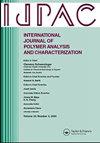Fabrication, optical behavior and structural characteristics of the poly (4-chloroaniline)/silver nanoparticles materials for optical devices
IF 1.7
4区 工程技术
Q4 POLYMER SCIENCE
International Journal of Polymer Analysis and Characterization
Pub Date : 2025-01-06
DOI:10.1080/1023666X.2024.2447000
引用次数: 0
Abstract
In this study, the flexible composite P(4-CAni)/AgNPs, which consists of poly 4-chloroaniline P(4-CAni) and silver nanoparticles (AgNPs), was successfully prepared using the polymerization preparation method. The results were confirmed by the transmission electron microscope (TEM), X-ray diffraction (XRD), and Fourier-transform infrared spectroscopy (FTIR). The XRD shows the successful fabrication of the composite and confirms that the pure P(4-CAni) has a typical pattern for the amorphous conducting polymer. The results of the TEM indicated the size of AgNPs in the range from 13 to 28 nm. In addition, the FTIR demonstrates that the AgNPs nanoparticles are uniformly interacted with the P(4-CAni). The wettability and adhesion work of the surface were determined by measuring the contact angle. Moreover, the band tail increased from 1.15 eV for the P(4-CAni) to 1.85 eV, 1.91 eV, and 1.96 eV when P(4-CAni) is mixed with 1.5%, 3%, and 4.5% AgNPs, respectively. Also, adding 1.5%, 3%, and 4.5% AgNPs decreases the band gap energy from 3.48 eV for the P(4-CAni) to 3.12 eV, 3.04 eV, and 2.90 eV, respectively. The interaction between P(4-CAni) and AgNPs enhances the structural properties of the composite, making the P(4-CAni)/AgNPs composite a multifunctional material suitable for various applications. The results demonstrate the fabricated nanocomposite materials exhibiting novel optical properties, which could lead to the use of these composites in optoelectronic devices.
光学器件用聚(4-氯苯胺)/纳米银材料的制备、光学性能及结构特性
本研究采用聚合法制备了由聚4-氯苯胺P(4-CAni)和纳米银(AgNPs)组成的柔性复合材料P(4-CAni)/AgNPs。通过透射电镜(TEM)、x射线衍射(XRD)和傅里叶变换红外光谱(FTIR)对结果进行了验证。XRD表征了该复合材料的成功制备,并证实了纯P(4-CAni)具有典型的非晶导电聚合物模式。透射电镜结果表明,AgNPs的尺寸在13 ~ 28 nm之间。此外,FTIR表明AgNPs纳米颗粒与P(4-CAni)相互作用均匀。通过测量接触角来测定表面的润湿性和附着力。此外,当P(4-CAni)与1.5%、3%和4.5% AgNPs混合时,带尾分别从P(4-CAni)的1.15 eV增加到1.85 eV、1.91 eV和1.96 eV。此外,添加1.5%、3%和4.5%的AgNPs将带隙能量从P(4-CAni)的3.48 eV分别降低到3.12 eV、3.04 eV和2.90 eV。P(4-CAni)与AgNPs之间的相互作用增强了复合材料的结构性能,使P(4-CAni)/AgNPs复合材料成为一种适用于各种应用的多功能材料。结果表明,制备的纳米复合材料具有新颖的光学特性,这可能导致这些复合材料在光电器件中的应用。
本文章由计算机程序翻译,如有差异,请以英文原文为准。
求助全文
约1分钟内获得全文
求助全文
来源期刊
CiteScore
3.50
自引率
5.30%
发文量
37
审稿时长
1.6 months
期刊介绍:
The scope of the journal is to publish original contributions and reviews on studies, methodologies, instrumentation, and applications involving the analysis and characterization of polymers and polymeric-based materials, including synthetic polymers, blends, composites, fibers, coatings, supramolecular structures, polysaccharides, and biopolymers. The Journal will accept papers and review articles on the following topics and research areas involving fundamental and applied studies of polymer analysis and characterization:
Characterization and analysis of new and existing polymers and polymeric-based materials.
Design and evaluation of analytical instrumentation and physical testing equipment.
Determination of molecular weight, size, conformation, branching, cross-linking, chemical structure, and sequence distribution.
Using separation, spectroscopic, and scattering techniques.
Surface characterization of polymeric materials.
Measurement of solution and bulk properties and behavior of polymers.
Studies involving structure-property-processing relationships, and polymer aging.
Analysis of oligomeric materials.
Analysis of polymer additives and decomposition products.

 求助内容:
求助内容: 应助结果提醒方式:
应助结果提醒方式:


